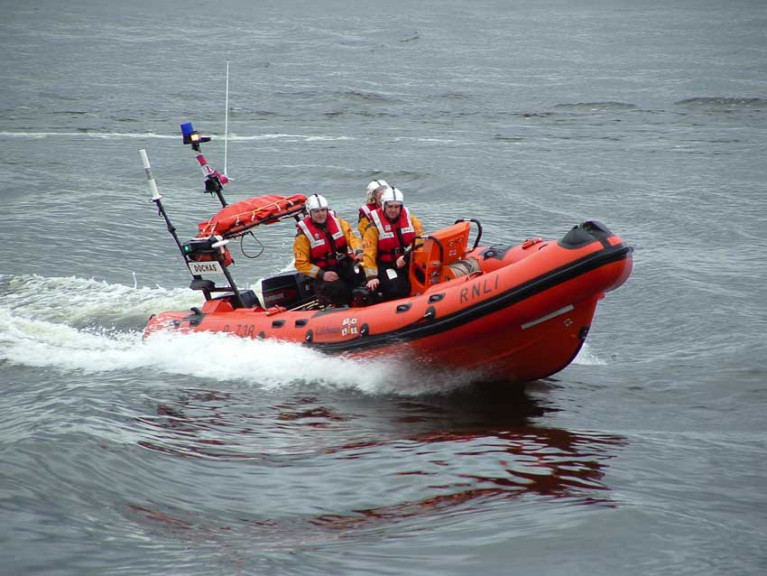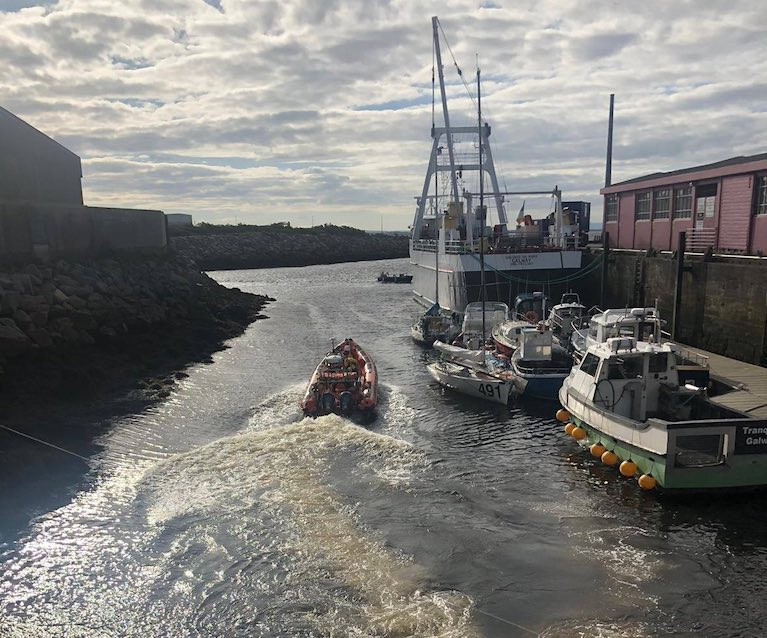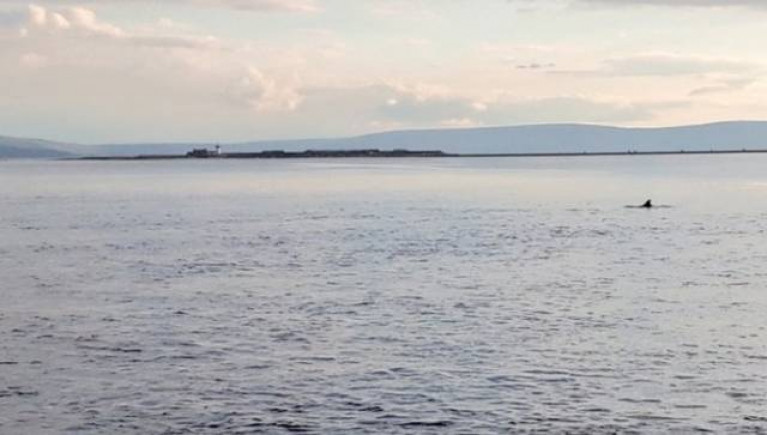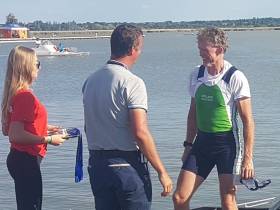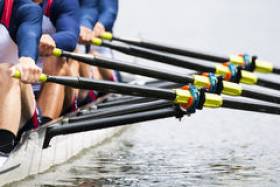Displaying items by tag: Galway
Wild Stocks in Key Western Salmon & Trout Fisheries To Get a Boost in New Projects
Improving stocks of wild salmon and trout in the West of Ireland in the goal of a new initiative launched by Inland Fisheries Ireland (IFI).
Derek Evans writes in The Irish Times about IFI’s partnership with Co Galway angling federation Cairde an Chláir to restore a near kilometre-long stretch of the Abbert River, a tributary of the River Clare.
Earlier this year the two groups signed a memorandum of understanding on the conservation and development of brown trout and salmon and their habitat, as previously reported on Afloat.ie.
While the coronavirus pandemic slowed progress over the year, IFI says the project is now at the stage where work on the river can begin — while a similar scheme to restore 8km of nursery streams such as the River Nanny is already under way.
The Irish Times has much more on the story HERE.
Member of Well-Known Fishing Family Dies in Incident Off Galway
Indepdendent.ie reports that a member of a well-known Galway fishing family has died after an incident on a vessel in Galway Bay this afternoon (Monday 2 November).
The alarm was raised at lunchtime by a man on board the boat which was located at the time between Blackrock and Silverstrand west of Galway city.
Galway RNLI were tasked to the scene by the Irish Coast Guard, and the lifeboat crew brought the casualty back to Galway Docks from where he was transported by ambulance to University Hospital Galway.
Dismasted Yacht Rescued in Galway Bay By RNLI
Galway RNLI has rescued a man whose yacht got into difficulty on Galway Bay this morning.
Galway RNLI says that the yacht was sailing from Barna to Ballyvaughan in Clare when the forestay broke and the mast crashed onto the deck.
The man was alone on the yacht and contacted the Irish Coast Guard which tasked sought the Galway inshore lifeboat at about 9.27 am.
It launched within minutes, and located the yacht off Furbo. The crew took the man on board and towed the yacht to Spiddal.
Galway Lifeboat deputy launch authority Shane Folan said the rescue was “not without difficulties”.
“There was a south west wind force four to five, a sea swell of one and a half to two metres, but thankfully we got the vessel safely to Spiddal,”Folan said.
The RNLI crew involved were helmsman Martin Oliver, Sean King, Lisa McDonagh and Greg Cullen.
Damage to Columbus Monument in Galway Condemned
A former Italian honorary consul has expressed disappointment at damage to a monument marking explorer Christopher Columbus’s links to Galway.
A Labour city councillor, Niall MacNelis, has also condemned the spraying of black paint on the monument, and says he has reported the matter to the Garda Siochána.
Adriano Cavalleri was honorary consul to Galway when the monument was unveiled in 1992 to mark the 500th anniversary of Columbus’s voyage to the Americas.
Mr Cavalleri explained it was intended to celebrate the navigation skills of Columbus and his crew, and the fact that he is believed to have docked in Galway port in 1477.
Late Italian historian and Columbus biographer Paolo Emilio Taviani had established that Columbus had called to the port and received chart information, Mr Cavalleri said.
“We wished to celebrate these maritime skills, and the link between Galway and Genoa where Columbus was from,” Mr Cavalleri said.
The Columbus monument was donated by the city of Genoa, and its installation close to the Spanish Arch was supported by the Italian Cultural Institute.
Earlier this week, People Before Profit called on Galway City Council to remove monuments which “glorified slavery and racism”, including the Columbus monument.
It also criticised a plaque in Tuam honouring Major Richard (Dick) Dowling who served with the Confederate Army in the US.
Cllr MacNelis said that conflating Columbus’s visit to Galway in 1477 with slavery did “no service to the Black Lives Matter campaign”.
“If this is the approach, where do we stop – does this mean we don’t remember the Galway soldiers who lost their lives while fighting abroad,” Cllr MacNelis said.
Nimmo The Bottlenose Dolphin Heralds Spring In Galway City
The traditional first day of spring in Ireland also saw the return of Nimmo, a bottlenose dolphin who’s become a regular visitor to Galway city.
The Irish Whale and Dolphin Group (IWDG) says this is the sixth consecutive year for this particular dolphin, who has stayed for anywhere between four and eight months since 2016.
As reported this time last year on Afloat.ie, Nimmo’s predilection for Galway Harbour is a sign that the area has become an important feeding habitat.
“This is a wonderful opportunity for people in Galway to observe a wild dolphin close to a city centre and often within clear view of the shoreline,” says IWDG sightings officer Pádraig Whooley.
He also calls on local citizen scientists and marine wildlife watchers to submit their own sightings over the coming months.
Conamara Sea Week Parade Tonight at Letterfrack, Galway
Giant “fire sculptures”, a community dinner, jazz lunch and a walk to Omey island are among activities planned for Conamara Sea Week’s programme based in and around the Quaker village of Letterfrack.
Ecologist Gordon D’Arcy is participating in a schools programme, and students from primary to third level have created images for the “After the Light” parade tonight, Wed October 23rd, from 7pm.
The award-winning festival, which has been running since 1984, is focused on the community, with a strong environmental focus.
“Myth, magic and a hint of madness” is promised for the mid-week parade, involving students from five primary schools, local crèches, Youthreach, Galway-Mayo Institute of Technology (GMIT) Letterfrack, the Galway Roscommon Education and Training Board and the Brothers of Charity.
An “active age club” lunch and music at Rosleague Manor takes place on Thursday, October 24th, and that same evening a community dinner in Veldon’s Seafarer will offer food made by award-winning chef Jonathan Keane of the Lodge at Ashford.
Artist Mo West will open a sea week “small works” art exhibition at Connemara National Park on Saturday (Oct 26), and John O’Halloran will lead a walk on Sunday to Omey island, meeting at Claddaghduff church at 10.30am.
The programme, including music of all genres, continues until bank holiday Monday, and further information is available by phoning 085 1154629 or check the website here
Crowley Leads Ireland to More Masters Wins in Hungary
#Rowing: Irish crews added four more wins to their haul over the weekend at the World Masters Regatta at Lake Velence in Hungary. The wins came on Saturday. Denis Crowley featured in a composite eight, which beat strong British opposition, and in a four – bringing his personal tally to eight wins. Brendan Smyth and Patrick Fowler of Commercial won in the double and Milo and Pat Murray of Cappoquin won the in the pair. A mixed eight finished second on Sunday.
World Masters Regatta, Lake Velence, Hungary (Selected Results; Irish interest; Winners)
Saturday
Men
Eight (E – avg 55 or more): Galway, Belfast BC, Neptune, Clonmel, Commercial, Shannon (G Murphy, A McCallion, K McDonald, D Crowley, F O’Toole, O McGrath, G O’Neill, C Hunter, M McGlynn) 3:04.90
Four (D – avg 50 or more): Commercial, Neptune (B Smyth, F O’Toole, G Murphy, D Crowley) 3:24.72.
Pair (F – avg 60 or more): Cappoquin (P Murray, M Murray) 6:12.10.
Sculling, Double (C – avg 43 or more): Commercial (B Smyth, F Fowler) 3:28.39.
Crowley a Six Shooter at World Masters Regatta
#Rowing: Denis Crowley of Commercial brought his tally of wins to a remarkable six after three days at the World Masters Regatta in Budapest. In just one day, the 57-year-old won in the coxless four and twice in the single sculls – in the C class (43 years or more) and the E class for 55 or more. The decision to form composite crews again paid off for the Irish, with wins in the C eight and the D coxed four, along with Crowley’s haul.
World Masters Regatta, Budapest, (Selected Results, Irish interest, winners)
Friday
Men
Eight
(C – 43 or more): Heat Four: Commercial, Cork, Neptune, Clonmel, Shannon, Galway, Castleconnell (B Crean, B Smyth, R Carroll, O McGrath, G O’Neill, P Fowler, B O’Shaughnessy, K McDonald; cox: M McGlynn) 3:09.75.
Four
(E – 55 or more) Heat Five: Commercial, Neptune, Belfast BC, Galway (D Crowley, G Murphy, C Hunter, A McCallion)
Four, coxed
(D – 50 or more) Heat 3: Galway, Neptune, Castleconnell, Clonmel (G O’Neill, O McGrath, B O’Shaughnessy, T Dunn; cox: M McGlynn) 3:35.89.
Sculling, Single
(C - 43 or more) Heat 19: Commercial (D Crowley) 3:49.92.
(E – 55 or more) Heat 8: Commercial (Crowley)
Ship Holed at South Galway Pier Detained by Irish Authorities as Residents Fear Pollution Risk
Irish authorities have detained a cargo ship close to Kinvara in south Galway bay after its hull sprang a leak while loading cargo for the Bahamas writes Lorna Siggins
The 30m ship Evora has been detained by the Marine Survey Office (MSO) under port-state control regulations which prevent the vessel from going to sea.
Concerns about the four crew employed for the voyage also prompted a visit to the vessel yesterday by the International Transport Federation’s (ITF) Irish branch.
ITF representative Michael Whelan said he had met the crew – three Cubans and a Colombian – and was assessing the situation in relation to pay, conditions, and accommodation for the crew while the vessel is damaged.
“The situation is ongoing, and I have been in contact with the vessel owner,” Mr Whelan said.
The cargo ship had been due to steam to the Bahamas with a large quantity of cement when the ship’s hull was damaged during loading at Tarrea pier, outside Kinvara.
Local residents feared that fuel from the ship might leak, causing pollution which would have a serious impact on south Galway’s shellfish industry, including its oyster beds.
The pier is outside the remit of the Galway harbourmaster and is the responsibility of Galway County Council.
It is understood residents found it difficult to get a response from the local authority, and Galway harbourmaster Capt Brian Sheridan then intervened to assist.
The Department of Transport, under which the Marine Survey Office operates, said it could not comment on the details of the detention.
It said that any queries should be directed to the ship’s flag state – as in Saint Vincent and the Grenadines, where the vessel is registered.
The vessel, built in France 50 years ago, was formerly owned in Co Galway but was sold to a new owner within the past 12 months. The owner confirmed that the vessel had been detained, but did not comment further.
A spokesman for the Evora said that the vessel was "detained due to flooding of the engine room" and that "no harmful substances were released" to surrounding waters.
The spokesman said there were "no further comments".
Irish Composite Crews Lead the Way at World Masters
#Rowing: A composite of five crews – Galway, Neptune, Commercial, Clonmel and Cork – won in the men’s eight for 50 and over at the World Masters Regatta in Budapest. It was one of a sequence of wins for the Irish at the huge event.
Brendan Smyth and Patrick Fowler, rowing for Commercial, won the Pair in the A class, while Denis Crowley and Tony Corcoran won in single sculls.
Two C fours (43 or more) won and an E coxed four (55 or more) also took the honours.
World Masters Regatta, Budapest, (Selected Results, Irish interest, winners)
Wednesday
Men
Four, coxed E (55 or more) – Heat Four: 1 Belfast BC, Commercial, Galway, Leichhardt RC (C Hunter, A McCallion, M Heavey, G Canning; cox: JM Marks) 8:05.40
Thursday
Men
Eight (D – 50 or more) – Heat Two: Galway, Neptune, Commercial, Clonmel, Cork (B Crean, B Smyth, R Caroll, O McGrath, G O’Neill, P Fowler, D Crowley, G Murphy; cox: M McGlynn) 3:05.06.
Four (C – 43 or more): Heat Three: Commercial, Galway, Clonmel, Neptune (R Carroll, O McGrath, P Fowler, G O’Neill) 3:15.28. Heat Six: Commercial/Neptune (D Smyth, F O’Toole, G Murphy, D Crowley) 3:15.54.
Pair (A – 27 or more): Heat Three: Commercial (P Fowler, B Smyth) 3:32.68
Sculling, Single – (D – 50 or more) – Heat 15: Commercial (D Crowley) 3:55.15.
(H – 70 or more) – Heat Eight: 1 T Corcoran 4:27.08.




























